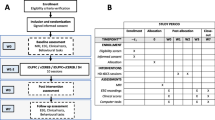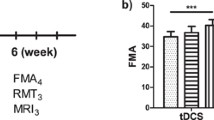Abstract
Objective
To investigate the mechanisms underlying the effect of repetitive transcranial magnetic stimulation (rTMS) on post-stroke hemiplegia, we assessed alterations in cerebral glucose metabolism.
Methods
Five post-stroke hemiplegic patients (three targeted for upper limb impairment and two targeted for lower limb impairment) aged 62.6 ± 6.1 years (mean ± standard deviation) with a duration since stroke onset of 3.5 ± 3.8 years participated in this preliminary study. Cerebral glucose metabolism was measured twice—before and after rTMS with intensive rehabilitation—using positron emission tomography with [18F]fluorodeoxyglucose. The Asymmetry Index (AI) was calculated to assess laterality of metabolism between the lesional and contralesional motor areas. The alteration rates of AI (%ΔAI) were compared between participants in whom rTMS was effective and ineffective.
Results
Two of the three upper-limb-targeted patients and one of the two lower-limb-targeted patients showed motor function improvements following rTMS treatment. All three patients who responded to rTMS had improved laterality of cerebral glucose metabolism in motor areas, commonly in the precentral gyrus, with an %ΔAI of approximately 10%. In contrast, the two patients who did not respond to rTMS had no improvements in laterality.
Conclusions
These results suggest for the first time that improved glucose metabolism is associated with improved motor function after a combination of rTMS and intensive rehabilitation.
Similar content being viewed by others
Data availability
Anonymized data are available by request to the corresponding author.
Code availability
Not applicable.
References
Chen R, Classen J, Gerloff C, Celnik P, Wassermann EM, Hallett M, Cohen LG (1997) Depression of motor cortex excitability by low-frequency transcranial magnetic stimulation. Neurology 48:1398–1403
Maeda F, Keenan JP, Tormos JM, Topka H, Pascual-Leone A (2000) Modulation of corticospinal excitability by repetitive transcranial magnetic stimulation. Clin Neurophysiol 111:800–805
Wu T, Sommer M, Tergau F, Paulus W (2000) Lasting influence of repetitive transcranial magnetic stimulation on intracortical excitability in human subjects. Neurosci Lett 287:37–40
Mansur CG, Fregni F, Boggio PS, Riberto M, Gallucci-Neto J, Santos CM, Wagner T, Rigonatti SP, Marcolin MA, Pascual-Leone A (2005) A sham stimulation-controlled trial of rTMS of the unaffected hemisphere in stroke patients. Neurology 64:1802–1804
Takeuchi N, Chuma T, Matsuo Y, Watanabe I, Ikoma K (2005) Repetitive transcranial magnetic stimulation of contralesional primary motor cortex improves hand function after stroke. Stroke 36:2681–2686
Fregni F, Boggio PS, Valle AC, Rocha RR, Duarte J, Ferreira MJ, Wagner T, Fecteau S, Rigonatti SP, Riberto M, Freedman SD, Pascual-Leone A (2006) A sham-controlled trial of a 5-day course of repetitive transcranial magnetic stimulation of the unaffected hemisphere in stroke patients. Stroke 37:2115–2122
Lefaucheur JP, André-Obadia N, Antal A, Ayache SS, Baeken C, Benninger DH, Cantello RM, Cincotta M, de Carvalho M, De Ridder D, Devanne H, Di Lazzaro V, Filipović SR, Hummel FC, Jääskeläinen SK, Kimiskidis VK, Koch G, Langguth B, Nyffeler T, Oliviero A, Padberg F, Poulet E, Rossi S, Rossini PM, Rothwell JC, Schönfeldt-Lecuona C, Siebner HR, Slotema CW, Stagg CJ, Valls-Sole J, Ziemann U, Paulus W, Garcia-Larrea L (2014) Evidence-based guidelines on the therapeutic use of repetitive transcranial magnetic stimulation (rTMS). Clin Neurophysiol 125:2150–2206
Wassermann EM (1998) Risk and safety of repetitive transcranial magnetic stimulation: report and suggested guidelines from the International Workshop on the Safety of Repetitive Transcranial Magnetic Stimulation, June 5–7, 1996. Electroencephalogr Clin Neurophysiol 108:1–16
Kakuda W, Abo M, Shimizu M, Sasanuma J, Okamoto T, Yokoi A, Taguchi K, Mitani S, Harashima H, Urushidani N, Urashima M, Investigators NEURO (2012) A multi-center study on low-frequency rTMS combined with intensive occupational therapy for upper limb hemiparesis in post-stroke patients. J Neuroeng Rehabil 9:4–14
Kakuda W, Abo M, Nakayama Y, Kiyama A, Yoshida H (2013) High-frequency rTMS using a double cone coil for gait disturbance. Acta Neurol Scand 128:100–106
Fugl-Meyer AR, Jääskö L, Leyman I, Olsson S, Steglind S (1975) The post-stroke hemiplegic patient. 1. A method for evaluation of physical performance. Scand J Rehabil Med 7:13–31
Podsiadlo D, Richardson S (1991) The timed “Up & Go”: a test of basic functional mobility for frail elderly persons. J Am Geriatr Soc 39:142–148
Takekawa T, Kakuda W, Uchiyama M, Ikegaya M, Abo M (2014) Brain perfusion and upper limb motor function: a pilot study on the correlation between evolution of asymmetry in cerebral blood flow and improvement in Fugl-Meyer Assessment score after rTMS in chronic post-stroke patients. J Neuroradiol 41:177–183
Könönen M, Kuikka JT, Husso-Saastamoinen M, Vanninen E, Vanninen R, Soimakallio S, Mervaala E, Sivenius J, Pitkänen K, Tarkka IM (2005) Increased perfusion in motor areas after constraint-induced movement therapy in chronic stroke: a single-photon emission computerized tomography study. J Cereb Blood Flow Metab 25:1668–1674
Colamussi P, Giganti M, Cittanti C, Dovigo L, Trotta F, Tola MR, Tamarozzi R, Lucignani G, Piffanelli A (1995) Brain single-photon emission tomography with 99mTc-HMPAO in neuropsychiatric systemic lupus erythematosus; relations with EEG and MRI findings and clinical manifestations. Eur J Nucl Med 22:17–24
Siebner HR, Peller M, Willoch F, Minoshima S, Boecker H, Auer C, Drzezga A, Conrad B, Bartenstein P (2000) Lasting cortical activation after repetitive TMS of the motor cortex: a glucose metabolic study. Neurology 54:956–963
Murase N, Duque J, Mazzocchio R, Cohen LG (2004) Influence of interhemispheric interactions on motor function in chronic stroke. Ann Neurol 55:400–409
Acknowledgements
We are grateful to the late Dr. Michitaka Matsubara, former Director of Department of Planning and Research, Nagoya City Rehabilitation Center, for his kind suggestions during his lifetime.
Funding
This study was funded by The Rehabilitation Research Fund of Social Welfare Corporation Nagoya City Rehabilitation Agency.
Author information
Authors and Affiliations
Contributions
All authors have read the manuscript and have approved this submission
Yoshihiko Horimoto recruitment of patients, performing TMS
Chikako Sato recruitment of patients, performing TMS
Aki Inagaki recruitment of patients, performing TMS
Emi Hayashi scanning and analyzing of images
Takuma Nozue assessment of impairment, performing rehabilitation
Suguru Morita assessment of impairment, performing rehabilitation
Yasuko Kondo performing TMS
Marina Funaki recruitment of patients, assessment of impairment
Akihiko Iida scanning and analyzing of images
Toshihisa Tajima recruitment of patients
Hiroaki Hibino recruitment of patients
Kazuo Yamada recruitment of patients
Hidehiro Kabasawa recruitment of patients
Corresponding author
Ethics declarations
Conflict of interest
The authors declare no competing interests.
Ethics approval
This study was approved by The Ethics Committee of Nagoya City Rehabilitation Center.
Consent to participate
All participants gave written informed consent to participate.
Consent for publication
All authors have read and agree with the contents of the manuscript for publication.
Additional information
Publisher's Note
Springer Nature remains neutral with regard to jurisdictional claims in published maps and institutional affiliations.
Rights and permissions
About this article
Cite this article
Horimoto, Y., Sato, C., Inagaki, A. et al. Effects of repetitive transcranial magnetic stimulation on cerebral glucose metabolism. Neurol Sci 43, 1879–1883 (2022). https://doi.org/10.1007/s10072-021-05539-x
Received:
Accepted:
Published:
Issue Date:
DOI: https://doi.org/10.1007/s10072-021-05539-x




